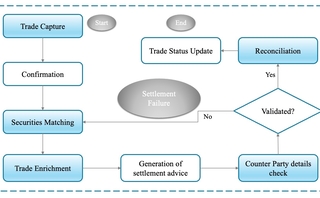Crypto ECNs aim to offer alternative to Clobs
CrossX and Cypator bring ECN-style trading and settlement to crypto, but rivals claim infrastructure isn’t ready

In the crypto market, central limit order books (Clobs) operated by centralized exchanges such as Binance have been the main home of retail and wholesale spot liquidity. These are all-to-all models where anyone can be a buyer or seller to the market, based on the aggregated market price at any given time of day, with the exchange acting as custodian.
For regulatory and risk management reasons, however, these exchanges are not suitable for most traditional finance (TradFi) participants, and those that are in the space typically trade spot crypto over the counter. But bilateral OTC trading can be time consuming when setting up relationships, and going via brokers can be expensive. Meanwhile, market participants must bilaterally settle trades with each counterparty.
In an attempt to attract more TradFi players to the market on the liquidity-maker and taker side, some platforms are offering venues that look and feel more like the electronic communication networks (ECNs) users would see in the foreign exchange space. These execution-only venues give access to multiple sources of maker and taker liquidity with centralized clearing via a prime broker or clearing house – which they claim ultimately leads to cheaper trading costs.
“You are ripping down costs all throughout the value chain,” says Brandon Mulvihill, founder and chief executive of Crossover Markets. “You don’t have that intermediary broker sitting in the middle that can mark up the spread – that’s totally eliminated in this business model,” he says.
Two venues, Crossover Markets’ CrossX and Cypator, operate quote-driven smart-order routing matching engines for spot crypto trading – common in FX but rare in crypto. They can receive a stream of quotes and the ECN’s smart-order router will decide how best to execute. This is based on the requested order type and existing market data, which sends orders to select market-makers that will respond with a trade.
In our quote-driven model there is protection, so the market-maker can simply reject a trade if there’s a bad actor
Brandon Mulvihill, Crossover Markets
This allows market-makers to adjust their pricing to match liquidity-taker behavior. Users that spray quotes widely and create market impact will receive worse prices, while well-behaved clients can be rewarded with tighter prices – something not possible on Clobs as prices are accessible by all.
“An all-to-all Clob model means market-makers have to price defensively, because you have no idea if the next trade is with a retail trader or if it’s from a high-frequency trader. In our quote-driven model there is protection, so the market-maker can simply reject a trade if there’s a bad actor,” says Mulvihill.
Like a foreign exchange ECN, the platforms do not provide custody or settlement services themselves. Users of both platforms must be signed up to a prime broker – Hidden Road Partners in this case – which handles the custody and settlement of the trades after execution. Users need to be onboarded to the broker and when trades occur, they are matched off centrally, with positions netted off.
Market participants connected to Hidden Road would be able to trade across any platform it is connected to, meaning they can hit the best price they see on either venue. Mulvihill says this is important, as on centralized exchanges where the platform holds custody of a user’s assets, they are beholden to that venue’s liquidity if they want to trade out or withdraw.
“Having a prime broker or a clearing counterparty now means that the second leg of the trade is no longer held captive – you can execute it on any other venue that’s available to you via your prime broker or clearing house. This means that you have real fungibility in digital assets for the first time,” he says.
Mulvihill says the netting and counterparty risk benefits of using a central counterparty allows for cheaper pricing from market-makers compared to trading in the OTC market, where settlement happens bilaterally.
“Historically in crypto, if you want to trade with 300 counterparties, then you’re settling bilaterally with 300 counterparties. Operationally, this is one of the most inefficient ways for institutional traders because capital is tied up with every trade and every time you buy with one counterparty, you have to sell with that same counterparty. There is no competition for the second leg of the trade, and competition is what drives down costs per trade,” he says.
Both venues offer anonymous multi-participant liquidity, with liquidity-takers being designated tags and bucketed into a particular user type. Market-makers can price this flow accordingly, with the option to not price a certain tag at all. Takers with “softer” flow can match with liquidity providers offering tighter spreads and skewed pricing. They also offer the ability for market-makers to provide clients with a stream curated for particular types of liquidity-taker, such as retail or institutional.
Cypator chief executive Ayal Jedeiken, however, says it is important for liquidity-takers to maintain anonymity.
“Anonymity is commonly used in FX – you’d never want to trade with somebody who knows your position, so it makes sense for you to use a crypto platform which is anonymous,” says Jedeiken.
Institutions are creatures of habit and require certain infrastructure as they look to adopt digital assets
Mike Higgins, Hidden Road Partners
Mulvihill adds CrossX can support anonymous, semi-disclosed and fully disclosed trading where clients can choose to see an aggregated book within a dark pool or individual price streams from liquidity providers that they can act on or against.
“It works like a ‘typical’ ECN, but it goes beyond the basic examples – that is, you can do more than view quotes [and] put out RFQs,” he says. “The platform supports one-to-one, one-to-many, and many-to-many interactions. We support fully disclosed, semi-disclosed and undisclosed environments and clients can choose to see an aggregated book or individual price streams from liquidity providers that they can act on or against as they see fit.”
Cypator recently reported a milestone of 100,000 trades cleared since going live in April, with 20 participants signed or onboarding. Jedeiken says a further 50 large institutional trading firms are in an “advanced stage of negotiations”.
In August, CrossX also announced it was connecting with the clearing house for Cboe Digital’s exchange. According to Mulvihill, it will allow firms to open a position at CrossX and offset it at Cboe Digital, and the clearing house will consider it flat from a risk perspective for spot and futures trades.
Mike Higgins, global head of business development at Hidden Road Partners, says the development of central clearing, prime brokerage, and execution-only trading platforms can only help bridge the gap for large TradFi institutions looking to get involved in crypto.
“Institutions are creatures of habit and require certain infrastructure as they look to adopt digital assets. What you’re starting to see are the early stages of that similar market structure from TradFi coming here,” says Higgins.
Dissenting voices
Not everyone agrees that ECNs are the future of institutional crypto trading, however. LMAX has long operated an exchange for institutional FX trading, and launched LMAX Digital to do the same for crypto in 2018.
But unlike the typical centralized exchanges in crypto, clearing and settlement is handled bilaterally by members, not by LMAX Digital.
Jenna Wright, managing director of LMAX Digital, says that while the ECN structure fits well inside TradFi infrastructure, it’s built for a process and structure that doesn’t currently exist in crypto markets.
“The ECN model is built largely for banks, but the custodian options available to them aren’t familiar. They want to custody with existing partners, backed by large balance sheets and established reputations,” says Wright.
“As it currently stands, banks can’t hold digital assets on their balance sheets without a capital charge. There are no truly scalable prime brokers in the crypto space, so until these challenges are addressed, the ECN model is unlikely to gain any significant scale.”
She adds that while segregating client assets is key, the process of credit intermediation can be managed inside existing frameworks that the market already has at its current scale.
Only users who have a paid subscription or are part of a corporate subscription are able to print or copy content.
To access these options, along with all other subscription benefits, please contact info@waterstechnology.com or view our subscription options here: http://subscriptions.waterstechnology.com/subscribe
You are currently unable to print this content. Please contact info@waterstechnology.com to find out more.
You are currently unable to copy this content. Please contact info@waterstechnology.com to find out more.
Copyright Infopro Digital Limited. All rights reserved.
You may share this content using our article tools. Printing this content is for the sole use of the Authorised User (named subscriber), as outlined in our terms and conditions - https://www.infopro-insight.com/terms-conditions/insight-subscriptions/
If you would like to purchase additional rights please email info@waterstechnology.com
Copyright Infopro Digital Limited. All rights reserved.
You may share this content using our article tools. Copying this content is for the sole use of the Authorised User (named subscriber), as outlined in our terms and conditions - https://www.infopro-insight.com/terms-conditions/insight-subscriptions/
If you would like to purchase additional rights please email info@waterstechnology.com
More on Emerging Technologies
Quants look to language models to predict market impact
Oxford-Man Institute says LLM-type engine that ‘reads’ order-book messages could help improve execution
The IMD Wrap: Talkin’ ’bout my generation
As a Gen-Xer, Max tells GenAI to get off his lawn—after it's mowed it, watered it and trimmed the shrubs so he can sit back and enjoy it.
This Week: Delta Capita/SSimple, BNY Mellon, DTCC, Broadridge, and more
A summary of the latest financial technology news.
Waters Wavelength Podcast: The issue with corporate actions
Yogita Mehta from SIX joins to discuss the biggest challenges firms face when dealing with corporate actions.
JP Morgan pulls plug on deep learning model for FX algos
The bank has turned to less complex models that are easier to explain to clients.
LSEG-Microsoft products on track for 2024 release
The exchange’s to-do list includes embedding its data, analytics, and workflows in the Microsoft Teams and productivity suite.
Data catalog competition heats up as spending cools
Data catalogs represent a big step toward a shopping experience in the style of Amazon.com or iTunes for market data management and procurement. Here, we take a look at the key players in this space, old and new.
Harnessing generative AI to address security settlement challenges
A new paper from IBM researchers explores settlement challenges and looks at how generative AI can, among other things, identify the underlying cause of an issue and rectify the errors.







